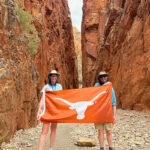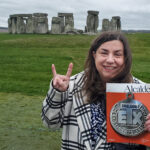The Authentication of George Covington
In which we discover a blind man who sees the world better than everyone else.
Last November, I drove way out West to see about a blind photographer. Actually, let’s stop right here—
If you want an inspirational story about a man overcoming his disability to become a celebrated artist, this ain’t it. In fact, that would be the surest way to piss off George Covington, BJ ’67, JD ’73. Yes he’s blind, yes he takes pictures, but he never did it to warm people’s hearts. He’s always been allergic to pity and cheerleading from strangers. Photography for him was a practical matter—a way to see beautiful women. “I never make a pass, until I make a print,” he says.
“Blind photographer” may sound like an oxymoron, but Covington uses the medium as an ingenious way to perceive the world. He’s not totally blind. He has a small percent of his vision, enough to allow him to sit at his computer and manipulate an image into a kind of sketch by bumping up the contrast. That way he can make out faces, vistas, and objects that were previously just a blur. When he first devised this trick as a student at UT Law in the ’70s, he was floored by what he saw. All his life, he said, he’d seen the world as a Monet painting, rich and colorful but maddeningly fuzzy. He had to fill in the detail with his own wild imagination. “I always thought I looked like a young Robert Redford,” he says, “but instead I found a young Groucho Marx.”
The drive from Austin to Alpine, Texas, population 5,927, is long, dusty, and severely lacking in cell phone reception. You wouldn’t want to do it for a phony.
After UT, Covington worked as a special assistant to Vice President Dan Quayle and helped pass landmark civil rights legislation for disabled Americans. He spent more than 20 years in the “political cesspool,” as he calls it, of Washington D.C. befriending and hitting the social circuit with fellow larger-than-life characters like Charlie Wilson. But it’s his unlikely passion for photography that brought him a new kind of fulfillment—and a new kind of attention. In 1992, George Plimpton and Jean Kennedy Smith profiled him in their book, Chronicles of Courage: Very Special Artists. Just this past year, he was featured as “The Visionary” in the coffee table book Authentic Texas: People of the Big Bend. Before I make the trip, Covington calls to make sure I have a copy. “I’m authentic!” he proclaims into the phone.
It’s a good thing he is. The drive from Austin to Alpine, Texas, population 5,927, is long, dusty, and severely lacking in cell phone reception. You wouldn’t want to do it for a phony.
Bill Wright, who co-wrote Authentic Texas, confirmed for me that Covington was the real thing and definitely worth my time. “He’s funny, he’s smart, and he’s got a weird sense of humor, as you probably know.”
I know now. A few days later, as I sit in the dimly lit living room of his apartment, I realize I’ve unwillingly bought a ticket to an erratic and absorbing one-man show. The thick smell of pipe smoke hangs in the air as Covington, a slender man in his 70s with powder-white hair and a dark mustache, stands in the center of the room for almost two hours. Poised, vigorous, hitting every mark, he recites the bulk of his life story in a smooth radio voice dripping with charm.
Covington was born in Texarkana in 1943 with roughly 20/400 vision, legally blind from a combination of astigmatism, nystagmus, eccentric fixation, myopia, and a degenerating retina. His exuberant personality was such a distraction, it took the adults a few years to realize that something was wrong. Most days Covington was kept after school at Grim Elementary for talking. His grandmother, whom he lived with at the time, thought that school let out an hour later than it actually did.
But even as a poor, loquacious blind child growing up in a time when there were virtually no accommodations for the visually impaired, Covington still thinks his origin story could use a little spice. “I begged my mother on her deathbed to tell me that I had been kidnapped by gypsies,” he says.
Toward the end of his monologue, Marguerite, Covington’s auburn-haired assistant, arrives with her unwieldy Labrador, Griffin. In the ensuing flurry of conversation I didn’t get the whole story of how these two met, but my understanding is that right after he moved to Alpine in 1997, Covington saw a little girl standing on the sidewalk outside the livestock arena holding the end of a ribbon that was tied to a goat. “It was like something out of a Dickens novel,” he says. He took her picture that day and they’ve been friends ever since. He calls her “Iddie Biddie” and she calls him “Mr. George.”
A short while later, I’m trailing Marguerite’s beat-up 1986 BMW sedan as Covington leads us on a tour of downtown Alpine. He’s riding shotgun and Griffin is hanging out of the back window taking in the air.
After we walk down Holland Avenue and tour its disproportionate number of art galleries, Covington insists on buying lunch at his favorite spot, the Cowdog trailer. As we’re standing in line, a local woman eyes from across the street and yells, “Hey, there’s George Covington, the world-famous writer!” He smiles and shouts back a polite correction: “Author, lover, statesman, and critic!”
It’s hard to put any kind of definitive label on George Covington. These days, in addition to his photography, he’s become a sort of desert Yoda through his witty and beloved column “High Desert Sketches” in the Big Bend Sentinel. He offers advice, bawdy wisdom, and commiserates with readers about life in West Texas.
As we dine on hot dogs, he continues to ruminate about this latest chapter of his life. “If I were a great promoter, I wouldn’t be living in little Alpine right now.” He isn’t claiming to be hiding from publicity—he is, after all, speaking to a reporter and a photographer—but I do have the sense that he’s pleased with his tucked-away life. It gives him just the right shade of mystery.
In 1997, Covington, a tumbling tumbleweed of a man, had been looking for a whistle-stop town full of artists and eccentrics with a university where he could write and take photographs. Alpine is that. On his first trip to the area, a friend took him to the top of a big hill on the Sul Ross State University campus that overlooks the town and the valley below. He couldn’t see much of it, of course, but he felt the cool, dry wind on his face and sensed that something was about to get right.
For his first 10 years in Alpine, Covington would wander around town with a camera and a magnifying lens and take pictures of the people he met. Then he’d rush home, open them in Photoshop, crop them in close, and get rid of all the color. When he had rendered all that visual information into a sketch, he could finally make out the face he had photographed. He was energetic and prolific. At one of his shows at the Museum of the Big Bend, he had sketches of about one-tenth of the town’s population on display. He made hundreds of friends this way, some of whom are surprised to see him out on the street today, since he usually hunkers close to his apartment on the edge of town.
“Good lord George! What are you doing here?” a woman says, rushing toward him. Covington cocks his head curiously in her direction. “Which one is that?” he asks.
Now that his vision has deteriorated even further with age, Covington can’t roam the way he used to. “One day I was walking down Del Rio Street, which I’d done for years and years,” he says, “and I was daydreaming and suddenly wound up in the middle of a field somewhere. A pickup truck drove by and a female voice says, ‘George, you lost or you exploring?’”
“Just keep talking so I can find the damn road,” he says he told her. “That sort of put an end to my daily walks, taking pictures of people and irritating the hell out of ’em.”
Through his newspaper column, Covington stays in touch with the people of the Big Bend. Even if he’s mostly out of sight these days, his voice carries across the region, bringing his trademark humor and observations to the public.
Wright says that as a photographer and writer himself, he’s drawn to the life that Covington has created. “Here is a guy who has become a part of their community,” he says. “They don’t suffer fools too easily, and they certainly don’t like people coming from Washington telling them how to live. They partake in his humor and they constantly feed it.”
After bidding Covington farewell and setting on the road back to Austin, I start to unpack the folder full of clippings and photographs that he sent home with me. Portraits of his (mostly female) friends; snapshots of the places that inspire him, like the ghost town cemetery in Terlingua; a shot of Covington on Air Force Two; and photos of him shaking hands with virtually every prominent politician of the ’90s. My favorite is a picture of a younger Covington in his office at the White House, scrunching his face as a group of women with feathered hair and glasses of champagne snuggle up to him. It’s signed: “To George, with love from some of his ladies. XXXOOO.”
It’s clear that ever since he set foot on this earth, Covington has been having a damn good time. Perhaps one or two poor souls have been offended by his humor along the way, but the people of Alpine have embraced his unusal persepctive. I guess there’s more than one way to look at things.
Above, from top: Covington returns to the place her first fell in love with Alpine; Covington, age 5, and his mother; Marguerite in downtown Alpine; Covington’s desk at home.
Photos by Anna Donlan





















4 Comments